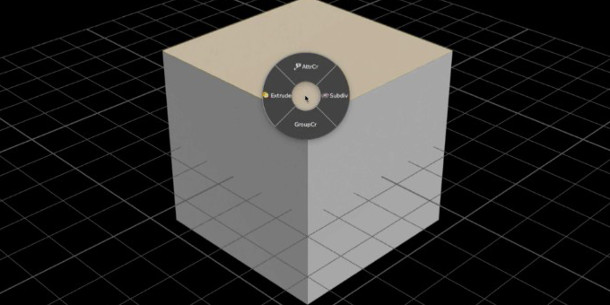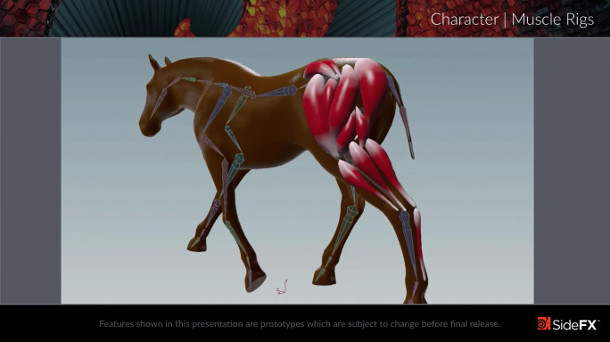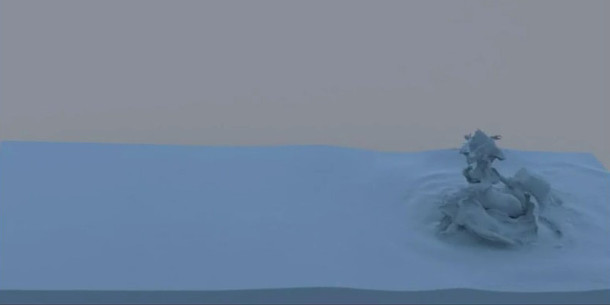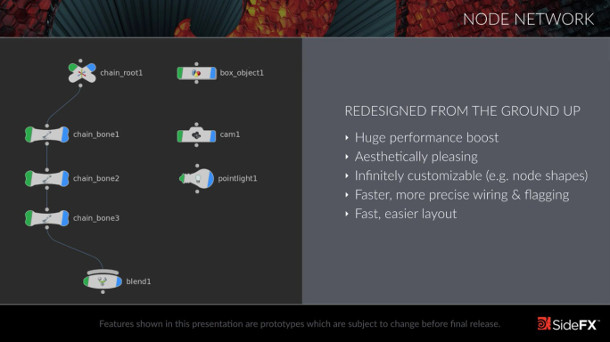Side Effects Software unveils Houdini roadmap
Side Effects has released details of its road map for Houdini, its 3D modelling, animation and simulation software, in the shape of a Siggraph presentation from senior product marketing manager Robert Magee.
The 15-minute video provides a glimpse of new modelling and rigging tools, including a new FEM-based muscle system; new fluid simulation options; and overhauls of Houdini’s node networks and Mantra renderer.
Although Magee doesn’t confirm all of the features will be in the next release of Houdini – which, if Side Effects sticks to its current naming convention, will be Houdini 16 – it seems clear that that’s the intention.
Updated: Side Effects has confirmed that all of the features shown will be in Houdini 16.
Generalist modelling and rigging tools; specialist simulation options
The new functionality on show breaks down between tools designed to appeal to Houdini’s traditional core user base of FX TDs, and a new, more generalist, audience attracted to the software through Houdini Engine.
In the latter camp, the modelling and character animation toolsets continue to play catch-up with those of less specialist DCC applications: a process begun in Houdini 15 and 15.5.

New radial menus for modellers
Modelers get new context-sensitive radial menus, speeding up tool selection. The version you can see above looks less detailed than the Maya equivalent, but Side Effects describes it as being a prototype.
Point modelling and retopology workflows, already substantially revamped in Houdini 15.5, continue to evolve: you can see some of the new tools around 07:00 in the video.

New autorigging and muscle simulation systems
The character animation toolset also gets a substantial update, including a new autorigging system.
As with other similar systems, users place a guide rig inside their character and adjust its proportions to match the limbs, then Houdini automatically generates a final rig complete with animation controls.
A nice feature is that those controls can then be hidden to allow animators to manipulate a character directly.
The video doesn’t specify whether the autorigger works for a range of creature types, or only on bipeds – but the demo for the new muscle and skin simulation system, which follows it, certainly shows a quadruped rig.
Updated: Side Effects tells us that the system will include a “variety of different kinds of body parts to fit many different kinds of characters and creatures”.
The muscle and skin system is based on the Finite Element solver introduced in Houdini 13, and looks to follow a standard workflow. You can see it in action around 11:00 in the video.
Side Effects says that it hopes that “in the next release, rigging and animating characters in Houdini will become a much more common occurrence”.

Guided fluid simulations, suction forces and accurate surface tension
For Houdini’s traditional user base, the fluid simulation toolset gets several new features that look likely to have TDs salivating, including physically accurate surface tension, a suction force and guided simulations.
The video doesn’t go into technical detail, but the results, shown at 05:25, look closer to keyframed animation than to tradtional unguided simulations.
Ocean surface simulations get new options to layer wave surfaces; and there are “new foam and spray methodologies”, although again, the video doesn’t go into detail.
Finally – not shown in the video, but listed among Side Effects’ development goals at the start – the crowd system introduced in Houdini 14 will also receive a further update, with the aim of generating foreground hero crowds, as well as mid- and background characters.

Node networks rewritten from the ground up
But the biggest change to Houdini’s existing toolsets looks to be that to its node networks, which receive a ground-up rewrite designed to make the editor more aesthetically pleasing, and faster and more precise to use.
You can see a preview above: the most obvious change is that the form of nodes now reflects their function – bones get bone-shaped nodes; chains, cross-shaped nodes; lights, light bulb-shaped nodes; and so on.
The shading network gets a similar overhaul, with each node now including a thumbnail preview of its output.
The update will also introduce a new layered material node, and a “feature-complete principled uber-shader”, which Side Effects tells us is based on the PxrDisney shader introduced in Houdini 15.5.
Houdini’s Mantra renderer also gets an update, with new adaptive sampling and per-pixel filtering options. Side Effects also claims that Mantra will be 10x faster on startup.
Pricing and availability
The next release of Houdini will be available to users on the annual upgrade plan at the “end of 2016”, with a public release to follow early in 2017. No changes to pricing have been announced.
The current release of Houdini, Houdini 15.5, is available for Windows, Linux and Mac OS X.
The full version, Houdini FX, costs $4,995; the base edition, which lacks the FX and dynamics toolsets, costs $1,995. Anyone earning under $100,000/year can use the output-limited $199/year Houdini Indie edition.
